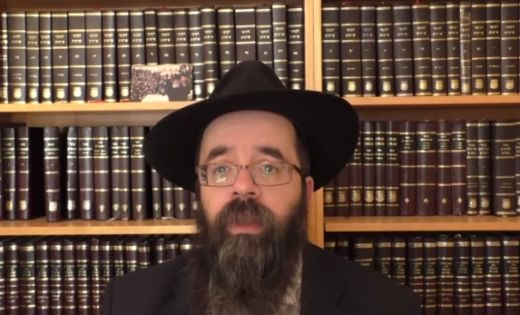The Endless Dance Of ‘Knowing G-D’ In The World To Come
From the desk of Rabbi Nissim Lagziel, Mashpia in Oholei Torah: This week, we will read parshas Beshalach which has, as its centerpiece, the splitting of the sea and the song of the sea. This is why this Shabbos is called “Shabbos Shira.” • Full Article
By Rabbi Nissim Lagziel, Mashpia in Oholei Torah:
BEGIN WITH A GRIN
The director of a circus once entered an inn and saw people crowded around an amusing sight. On the counter stood on overturned pot on which a duck was dancing.
The circus director was so impressed by this that he immediately decided to buy the duck. After some negotiations, the duck was sold for no less than $10,000!
Two days later, the director was back at the inn. He was furious and he shouted at the innkeeper, “Your duck is a fraud! I put it on an overturned pot and it didn’t dance!”
The innkeeper calmly asked, “Did you light a candle under the pot?”
WHAT DO YOU KNOW?
This week, we will read parshas Beshalach which has, as its centerpiece, the splitting of the sea and the song of the sea. This is why this Shabbos is called “Shabbos Shira.” The song of the sea is the first song written in the Torah, although in the Medrash we find the first song in the Torah attributed to Adam when he was forgiven for the sin of the Eitz HaDaas on Shabbos, in Gan Eden. He immediately said, “Mizmor shir l’yom ha’Shabbos, tov l’hodos l’Hashem,” but this song is not written in the Torah.
Our Sages find many allusions in this song of the sea. For example, G-d’s name YHVH appears nineteen times which is the number of blessings in the Shemone Esrei. Another thing we find, which we will focus on, is connected with the words, “Zeh Keili v’anveihu” from which our Sages learn that “a maid saw at the sea what the prophets did not see,” not even Yechezkel ben Buzi who saw the Merkava, a G-dly revelation which is unprecedented in history (except, perhaps, for Mattan Torah).
We also find in the Medrash that the G-dly revelation at the splitting of the sea pales in comparison to the G-dly revelation we will have with the coming of Moshiach and the Geula. On the words “Zeh Keili” the Medrash says (Shemos Raba 23, 15), “The Holy One blessed be He said to the Jewish people, in this world you said ‘Zeh Keili’ before Me one time. In the future, you will say it two times as it says (Yeshaya 25:9), “And they shall say on that day, “Behold, this (zeh) is our G-d: we hoped for Him and He will save us; this (zeh) is the Lord for Whom we hoped; let us rejoice and be happy with His salvation.”
At first glance, the Medrash is most surprising. What’s the big deal in saying “this” two times? How do we see in this verse that the revelation in Yemos HaMoshiach will be greater? Most people would say that repeating things is boring, annoying and pointless, or… is it stammering? At the end of the tractate Taanis (31a), the Gemara brings a similar teaching and compares it to the verse in Yeshaya, a teaching that sheds some light on these questions.
The Gemara says, “In the future, the Holy One blessed be He will make a dance for the righteous and He will sit among them in Gan Eden and each of them will point with his finger.” As proof, the Gemara cites the verse above from Yeshaya. The Rebbe, in an amazing explanation notes that the first “this” is completely unlike the second “this!” If we pause for a moment and examine the verse again, we will see that there are many differences between the first half of the verse and the second half which will teach us the significant difference between the first time “this” is said and the second.
First of all, the word “this” at the beginning of the verse goes with the name “Elokim” (Elokeinu zeh) whereas the second “this” goes with the name YHVH. In part one of the verse there is an introduction, “Behold, this is our G-d,” which it doesn’t say in the second part. The first part ends with the word meaning “and He will save us,” while the second part of the verse ends with the word meaning “His salvation.” What then, is the hidden meaning behind these three differences and what does it teach us about the true and complete Geula?
We will begin by saying that in the apprehension of G-d there are two general ways. The first way is called “positive apprehension,” i.e. when a person grasps the idea itself, he grasps and understands well the ‘whatness’ (i.e. knowing something by what it is) of the subject matter he is dealing with. In contrast, there is a second way called “negative knowing,” when it is not possible to understand the depth of something in a direct and positive manner but rather, by negating everything that contradicts it (i.e. knowing something by what it’s not). As such, it’s possible to have some tenuous grasp of the level that is under discussion.
TO KNOW WHAT YOU DON’T KNOW
For example; there are some aspects of G-dliness which have been invested into our reality and descended to the level that a human being can relate to, which can be understood through “positive apprehension” with examples and allegories from physical reality and daily life, i.e. things that we can grasp, but now we grasp their true reality. In contrast to this, those aspects of G-dliness which are beyond the bounds of nature, are not grasped in the world of intellect since the intellect is limited and G-d is unlimited. Those lofty concepts can only be grasped by our negating from them everything we already know and grasp, i.e. the more we know what it is not, the more we can have some potential supposition of what it is.
Generally speaking, Chassidus associates “positive apprehension” with the name “Elokim,” the numerical equivalent of ‘ha’teva’ which alludes to the level of G-dliness invested into the finite reality of nature and created existence. In contrast, “negative knowing” is generally associated with the name YHVH which alludes to the level of G-dliness which is above nature, was-is-will be at the same time with no divisions and limitations of time and place, something which does not exist in nature.
Now we can explain what the Gemara is teaching us about the Geula and what lies hidden in the wording of the verse in Yeshaya. First of all, in the future, we won’t only understand but will see. We will see with our minds, and ultimately with our senses, all the concepts and levels which we read about until now in books. This is learned from the word “this” – pointing with a finger and saying, this! Everything we understand we will be able to see and point at.
Second, the repetition of the word “this” and the repetition of the wording in the verse in Yeshaya, alludes to the types of G-dly apprehension which we mentioned earlier. The first part of the verse (“Behold, this is Elokeinu – our G-d”) alludes to “positive apprehension;” we will understand (and see) the name “Elokim” to the fullest extent to the point that that we will call Him “our G-d.” The G-d that we understand so well becomes “ours,” a part our very essence! This also nicely explains the double “behold” and “this” before and after the name of G-d. It comes to emphasize the bond, the belonging and our closeness to that which we understand and see.
Contrariwise, the second part of the verse alludes to “negative knowledge associated with the name YHVH which is why it does not say “behold” since this name is still distant from us and beyond our reality. We will see it “this” (zeh), but it will be in a way of abstract perception like someone seeing something astounding, something he never dreamed of. He sees it but it’s extraordinary to him and beyond him.
This is also the reason for the difference between the salvation in the first part of the verse and the salvation in the second half. The first part describes the closeness to us and our world of perceptions, which is why the salvation that ensues as a result of that G-dly revelation is described as “He will save us,” our personal and communal salvation according to our needs and the conditions of our existence. The second part, which describes the G-dly revelation beyond our capacity to apprehend and know directly, leads to a completely different level of salvation. This is “His salvation,” the salvation of G-d Himself, a salvation which is caused by the revelation of His essence, above all finite bounds of created beings.
Complete apprehension of G-dly matters will take place specifically in the future. This amazing level of apprehension is described by the Gemara as a “circular dance” which G-d will make for the righteous. The dance is a circle, without beginning or end. This endless dance in the Geula teaches us that we will never remain on the same level, not in apprehending the positive and not in knowing the negative. We will progress every day and every hour. What we were able to grasp yesterday only by abstraction will be understood today as concrete understanding. Yesterday, what was in the category of a mystery will today be understood, each on his level. Then, what seemed to us to be a repetition of a little word, will be a source of inspired living in the world of G-dly knowledge.
TO CONCLUDE WITH A STORY
We will end with an interesting yechidus which will teach us about the importance of the “circular dance” of Torah – the chayus and endless growth in Torah study. Rabbi Chaim Sholom Deitsch had his second yechidus in 5734:
“I was responsible for the Tzemach Tzedek Kollel in the Old City. Before that yechidus, I submitted a Torah anthology pamphlet that we published. The Rebbe responded, ‘Worthwhile to add in depth in the future,’ i.e. in future publications we should add more depth to the divrei Torah. In yechidus, I asked the Rebbe what he meant by this answer.
“The Rebbe explained, ‘In Lubavitch and Kremenchug (in both towns there were Chabad yeshivos) there were no kollelim. We founded the kollelim for those men who have enthusiasm for learning so they would have the opportunity to continue learning. In the end, it turned into a “genteel living.” Although “they do their work faithfully,” coming on time, where is the enthusiasm for learning?’ The Rebbe said this forcefully and I could see how much he cared about this.
“He then said, ‘Enthusiasm for learning is when he is walking in the street and stops a Jew to tell him, listen to the reasoning I just came up with.
“I saw the anthology. Someone with a good head asks a question and gives a good answer, but I don’t see the enthusiasm for learning. This is not why we founded the kollelim!’”
Good Shabbos!
20
Join ChabadInfo's News Roundup and alerts for the HOTTEST Chabad news and updates!












































